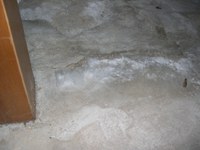Is It Mold or Isn’t It?
(Click the image below to view a high-resolution image that can be downloaded)
Concern about health effects from mold exposure has people looking for mold in damp conditions created by high water tables and flooding.
“However, as people scour their homes for mold, what they find may not necessarily be mold,” says Ken Hellevang, agricultural engineer with the North Dakota State University Extension Service. “In some cases, what they’re finding are mineral deposits, not mold.”
The wet, humid conditions that contribute to mold growth in basements are often the result of moisture vapor coming through the concrete floor or wall due to a high water table or saturated soils. If water comes into contact with basements that are drained or sealed inadequately, moisture will seep slowly through the wall and floor, Hellevang explains. The result is not only a damp environment, but also mineral deposits (salts) left behind as water evaporates from basement walls and floors.
As water evaporates through time, salt crystals grow and become obvious to the naked eye. These crystals can take many different forms, depending on the relative amounts of sodium, calcium, magnesium, carbonate, chloride and sulfate or other physical factors such as the rate of evaporation.
Sodium and magnesium sulfates are found frequently in North Dakota. These salts are dissolved and transported in groundwater readily. When they are deposited on basement walls and floors, they often take on a white, fluffy or moldy appearance in cracks in the floor or wall. These deposits are dissolved easily by water. Putting a few drops of water on the substance is one way to determine if it is salt or mold.
Calcium and magnesium carbonates also are found throughout North Dakota, but they are relatively insoluble in water. Upon evaporation, they cause light-colored, powdery deposits that accumulate during relatively long periods of time. These deposits can be removed with a dilute acid solution, such as vinegar, but cannot be removed effectively with water alone. The white plaque that often is seen on plumbing fixtures and in water tanks or on basement walls and floors is carbonates. If the substance does not dissolve with a few drops of water, try using a few drops of vinegar. If the substance does not dissolve in either water or vinegar, then it may be mold.
Deposits of soluble salts on basement walls and floors are harmless from a human health standpoint. However, groundwater with a high concentration of sulfate (more than 150 parts per million) is corrosive to concrete basements. Sulfate corrodes concrete by degrading the cementing agent and by forming crystals in the pores that eventually expand and physically break down the internal structure of the concrete.
“As one might expect, as the amount of sulfate in the groundwater increases and the longer the concrete basement is in contact with groundwater, the greater the damage from corrosion,” Hellevang says. “Solutions to this problem include a proper tile drainage system around the basement foundation and floor that quickly removes water from the immediate area of the basement.”
For information about preventing mold growth and other flood recovery efforts, visit NDSU’s flood information Web site at http://www.ag.ndsu.edu/disaster/flood.html.
NDSU Agriculture Communication
| Source: | Ken Hellevang, (701) 231-7243, kenneth.hellevang@ndsu.edu |
|---|---|
| Editor: | Ellen Crawford, (701) 231-5391, ellen.crawford@ndsu.edu |


